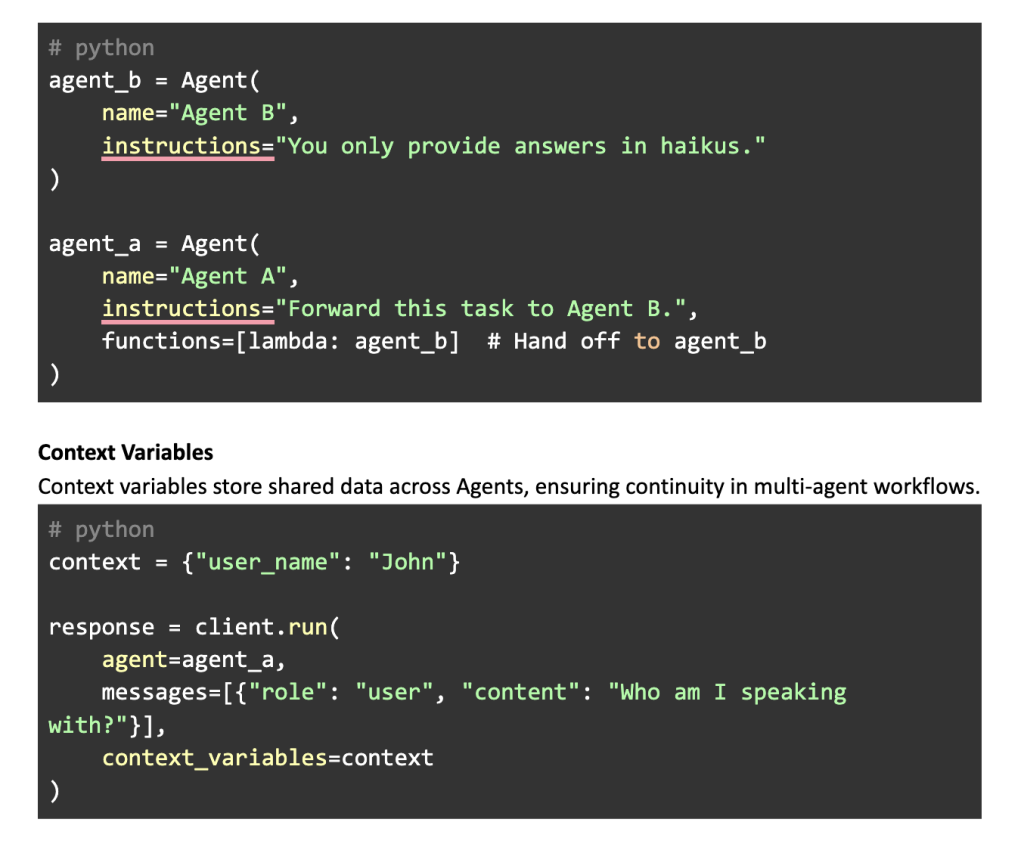

Swarm is an innovative open-source framework designed to explore the orchestration and coordination of multi-agent systems. It is developed and managed by the OpenAI Solutions team, and it provides a lightweight, ergonomic, and educational environment for developers to learn and experiment with agent-based systems. At its core, Swarm is built to facilitate the interaction of autonomous Agents, i.e., independent units capable of performing specific tasks, through streamlined handoffs and routine management. While primarily aimed at educational use, the framework introduces patterns and abstractions that make multi-agent orchestration more accessible and comprehensible. By focusing on simplicity and modularity, Swarm allows users to design workflows where Agents can collaborate, delegate tasks, and share contextual data seamlessly. OpenAI’s Chat Completions API entirely powers it; Swarm operates statelessly, ensuring security and flexibility. With no official support or production readiness, Swarm is a learning platform.
Core Components of Swarm
Swarm is built on fundamental components that provide a strong foundation for flexibility and functionality. These components include:
Agents
Agents are the primary units in Swarm, each representing an independent actor or step in a process. They include:
- Instructions: Define the Agent’s behavior or task.
- Functions: Specify actions the Agent can perform, including function calls.
- Handoffs: Allow the Agent to delegate its task to another Agent.
Agents are initialized as follows:
# python
from swarm import Agent
agent_a = Agent(
name="Agent A",
instructions="You are a general-purpose assistant.",
functions=[] # Add any callable functions here
)Handoffs
Handoffs enable one Agent to pass control to another seamlessly. This allows specialized Agents to handle tasks better suited to their capabilities.
# python
agent_b = Agent(
name="Agent B",
instructions="You only provide answers in haikus."
)
agent_a = Agent(
name="Agent A",
instructions="Forward this task to Agent B.",
functions=[lambda: agent_b] # Hand off to agent_b
)Context Variables
Context variables store shared data across Agents, ensuring continuity in multi-agent workflows.
# python
context = {"user_name": "John"}
response = client.run(
agent=agent_a,
messages=[{"role": "user", "content": "Who am I speaking with?"}],
context_variables=context
)How Swarm Works
At its core, Swarm processes interactions using a structured loop implemented in its ‘client.run()’ method. The loop involves the following steps:
- Message Processing: The current Agent processes the user’s message, which may generate a response or call a function.
- Function Execution: If the Agent includes function calls, these are executed, and the results are added to the conversation.
- Agent Switching: If the task requires another Agent, Swarm handles the handoff, ensuring seamless execution.
- Context Management: Context variables are updated throughout the interaction, ensuring shared data is accessible across Agents.
- Response Delivery: Swarm delivers the final response to the user after completing all steps.
The basic workflow is illustrated below:
# python
from swarm import Swarm
# Initialize the Swarm client
client = Swarm()
# Run the process
response = client.run(
agent=agent_a,
messages=[{"role": "user", "content": "What can you do?"}]
)
print(response.messages[-1]["content"])Usage of Swarm – Code Implementation
Installation
Swarm can be installed directly from its GitHub repository:
# bash
pip install git+https://github.com/openai/swarm.gitBasic Setup
Setting up Swarm involves importing the library, creating Agents, and running the interaction loop.
# python
from swarm import Swarm, Agent
# Initialize Swarm client
client = Swarm()
# Define Agents
agent_a = Agent(
name="Agent A",
instructions="Provide general assistance."
)
agent_b = Agent(
name="Agent B",
instructions="Respond to all queries in poetic form."
)
# Interaction
response = client.run(
agent=agent_a,
messages=[{"role": "user", "content": "Who am I speaking to?"}]
)
print(response.messages[-1]["content"])Advanced Features
Swarm supports advanced features, including streaming responses and debugging.
Streaming Responses:
# python
stream = client.run(
agent=agent_a,
messages=[{"role": "user", "content": "Stream a response"}],
stream=True
)
for chunk in stream:
print(chunk)Debugging:
# python
response = client.run(
agent=agent_a,
messages=[{"role": "user", "content": "Debug this process"}],
debug=True
)Conclusion:
Swarm is an ergonomic, lightweight, and educational open-source framework that lets developers try out patterns and techniques essential for scalable agent orchestration. Although not meant for production, its focus on accessibility, modularity, and testability makes it a valuable resource for learning and prototyping. Its ability to support complex workflows through simple abstractions, such as Agents, handoffs, and context variables, allows developers to design effective solutions without being overwhelmed by technical complexities.
Sources
- https://github.com/openai/swarm
- https://colab.research.google.com/drive/1uFquKQvXLpKeP05OD507UFl8d0YvhM1t?authuser=1
The post Swarm: A Comprehensive Guide to Lightweight Multi-Agent Orchestration for Scalable and Dynamic Workflows with Code Implementation appeared first on MarkTechPost.
Source: Read MoreÂ



